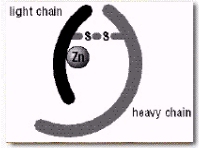The Botulinum toxins are proteins consisting of around 1,300 amino acids.
The ordering of these amino acids varies across the seven different toxin
types (A-G), however they each possess similar molecular weights and structures.
The toxins may be synthesized as single chain polypeptides, having a mass of around 150kDa. (Where 1Da = 1Dalton ~ Mass of one Hydrogen atom.) The toxin in this form has very little effect in the neuro - toxic mechanism.
The level of potency may be increased in two steps, the first of which involves cleavage of the chain giving a large chain (100kDa) connected to a smaller chain (50kDa) associated with a single zinc atom. The two chains are joined by a single disulphide bond. In naturally occurring toxins this first step is normally carried out by the producing bacteria.
The second
activating step sees the reduction of the adjoining disulphide bond, this
process only occurs during the internalization step of the neuro-toxic mechanism.

Above: Basic structure of a Botulinum Toxin, with a large and small chain joined by a di-sulphide bond.
The toxic effect on organisms may also be increased by the addition of non-toxic proteins, which act to protect the neurotoxin from hindering enzymes in the gut.